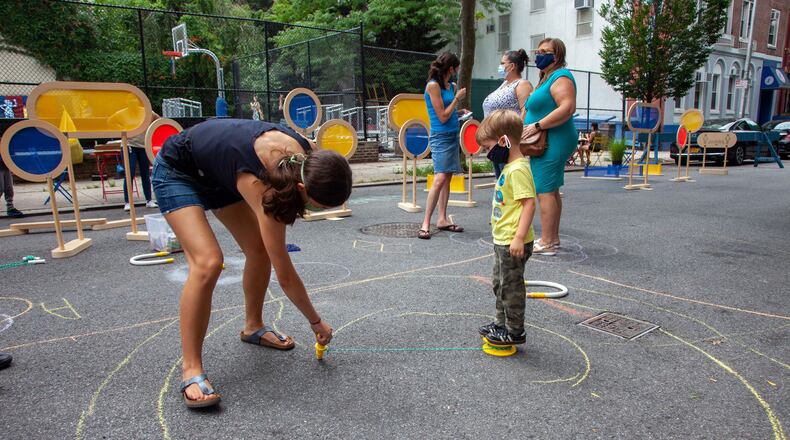It is a hot and humid Tuesday in Red Hook, Brooklyn, but a few brave children have come out to play.
Stretching along a segment of 9th Street, between Hicks and Henry, a colorful obstacle course welcomes its first guests for the day. A little girl hops over the hurdles, hand in hand with her mother. A young boy follows suit, surgical mask strapped around his face and wet Crocs squeaking from the open fire hydrant across the street. It is 1 p.m, and the Red Hook Open Street is open for play.
Play streets — an intervention that helps increase outdoor play by temporarily closing designated public streets to traffic — are a longstanding tradition in New York City, but the pandemic has put them at risk.
Over the summer, Mayor Bill de Blasio brought a little bit of them back with a new initiative aimed at providing families with safe, structured activities in the wake of COVID-19.
The revamped Play Streets initiative builds on Open Streets — a program that allows pedestrians and cyclists to use the roadbed of the street to allow for greater social distancing — and includes programs like giant board games, reading corners and sports for children.
As a part of Play Streets, New York City-based organization Street Lab has even reinvented the obstacle course to allow for social play in a time of social distancing.
Street Lab, a nonprofit that creates street furniture and programs for public spaces, is well acquainted with social play. Since 2011, the organization’s pop-up programs have been transforming plazas, parks, streets and awkward corners into spaces for learning, drawing, building and playing.
But when the pandemic set in, they had to rethink their programming from the ground up.
“It used to be a lot of shared materials,” said Leslie Davol, who co-founded Street Lab with her husband, Sam Davol.
Before the pandemic, activities included building with Legos and collective reading. The new safety requirements for social distancing have made all that impossible. So Street Lab launched PLAY NYC, a program that supports safe, hands-free play for children in high-need neighborhoods.
The set-up includes a no-touch obstacle course, exercise activities and learning experiences in low-income neighborhoods from Bushwick to Red Hook to East Harlem.
“We tend to prioritize locations that are underserved, even with Open Streets,” said Leslie Davol.
At the Red Hook Play Street, PLAY NYC has been a little slower to take off.
On that sweltering Tuesday afternoon, only half a dozen children were present.
“Since the pandemic set in, people are more wary, they leave the house for specific reasons,” said Leslie Davol. “At this moment, it’s important to occupy the streets so people notice.”
This is where design comes into play.
“Kids have been drawing obstacle courses forever,” said industrial designer Hannah Berkin-Harper, who drew inspiration from the obstacle courses she draws for her own 6-year-old daughter, then made it three-dimensional.
Unlike seesaws or climbing structures, the obstacle course provides a fun activity without the high-touch surfaces.
“One of the interesting things about the obstacle course is that kids make up their own rules,” said Berkin-Harper, who tested the structure on her driveway with her daughter.
At Van Dyke Houses in Brownsville, the balancing beam was declared too easy and the floor around it was chalked into lava.
The fluctuating environment made modularity a key component of the design process. The obstacle course is a kit of parts where plywood provides the structure and nylon awning mesh adds texture and a touch of color. A set of side barriers is placed along the edge of the obstacle course, to define the space while leaving room for passers-by.
Naturally, the process relies on trial and error.
“It’s hard to design for pop-ups compared to playgrounds that abound with regulations,” said Berkin-Harper. “What you can plan for is to use materials that are lightweight, so if they get knocked over, they’re very light.”
But finding the perfect balance between sturdy and knock-down is challenging.
At first, the side barriers were too light. Conversely, the mist house — a house-shaped skeleton made out of connected pipes that support misting hoses — was too heavy.
Berkin-Harper, who will be teaching a design-and-build course about Play Streets at Pratt Institute this fall, hopes to engage her students to come up with smart solutions for shade, seating, cooling, and multigenerational set-ups.
Street Lab is already thinking about catering to multiple generations.
Their new street-marking kit is another step towards a program that reimagines how neighbors can come together safely.
Since they were first invented, play streets have been on a steady decline.
According to a 2015 article in The New York Times, there were only 15 play streets then — down from a peak of around 150 two decades ago. Historically, most Play Streets were administered by the Police Athletic League, an independent youth development organization funded by NYPD, but declining public money and a laborious application process have led to the slow disappearance of a summer institution.
Drivers have had something to do with it, too.
Now, said Sam Davol, restaurants are relying on Open Streets to stay afloat.
“Everyone is realizing that there’s a tremendous amount of real estate in streets and we could be more creative in using it,” he said.
And people are already taking advantage of reclaimed streets to do census outreach and food distribution.
“They’re all Play Streets, they’re all Open Streets,” said Leslie Davol. “Let’s use them!”
Elissaveta M. Brandon writes for Next City, is a nonprofit news organization that believes journalists have the power to amplify solutions and help spread them from one city to the next.
This story is part of the SoJo Exchange of COVID-19 stories from the Solutions Journalism Network, a nonprofit organization dedicated to rigorous reporting about responses to social problems.
About the Author
Keep Reading
The Latest
Featured


